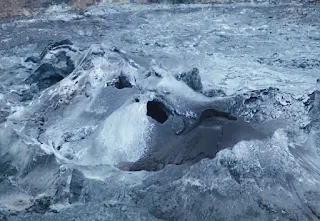Mysteries of the Coolest Black Lava Volcano
Being different is cool, just like the unique black carbonatite lava of Ol Doinyo Lengai in Tanzania that erupts black and cool to the touch. While most people might associate volcanoes with red-hot, molten lava, this exceptional volcano stands out by producing dark, cooler lava, setting it apart from the ordinary.
Coolest Black Lava Volcano
Ol Doinyo Lengai, a mesmerizing volcano in Tanzania, is a geological wonder. What sets Ol Doinyo Lengai apart is its unique volcanic activity. Unlike many other volcanoes that spew molten lava, this volcano erupts with a special lava called carbonatite.
Carbonatite lava is naturally black or very dark in color. This dark appearance is due to its unique composition, which includes minerals rich in iron, copper, cerium, calcite, neodymium, lanthanum, calcium, sodium, and potassium carbonate, to name a few. Unlike the bright red or orange hues we often associate with traditional silicate lava, carbonatite's black color sets it apart and contributes to its distinctiveness.
When Ol Doinyo Lengai erupts, it doesn't produce the fiery flows we associate with volcanoes. Instead, it releases black, cool to the touch lava, a mixture of sodium carbonate, calcium carbonate, and other minerals. This unique eruption style results from the carbonatite lava's low viscosity, allowing it to flow easily and create distinctive cone-shaped formations around the vent.
This volcano, standing at an impressive height of about 9,711 feet or approximately 2,960 meters, is part of the East African Rift system. This natural phenomenon is a fracture in the Earth's crust, gradually pulling apart the African continent.
Ol Doinyo Lengai is a Tanzanian volcano known for its black carbonatite lava eruptions.
Unlike the fiery and molten lava that comes to mind when we think of volcanoes, carbonatite lava is cool and dark. Carbonatite is fascinating because it has an extremely low viscosity, meaning it's not as thick and sticky as typical lava. This low viscosity allows it to flow easily, creating distinctive volcanic features. When carbonatite lava erupts, it often forms steep-sided cones and unique volcanic structures.
When carbonatite lava erupts, it has the remarkable tendency to create distinctive and visually striking volcanic formations. Unlike the more common silicate lava, which often flows gently and forms broad, shield-like volcanoes, carbonatite lava flows at lower temperatures and with less viscosity.
This leads to the rapid buildup of steep-sided cones, strikingly different from the classic, gently sloping volcanoes. These cones, often with near-vertical sides, emerge as the lava accumulates around the vent. This unique property of carbonatite lava contributes to the creation of landscapes.
Black carbonatite lava is much cooler than the typical red molten silicate lava.
Carbonatite lava is significantly cooler than molten silicate lava in many volcanoes. While silicate lava can reach temperatures of around 1,200 to 1,300 degrees Celsius or 2,192 to 2,372 degrees Fahrenheit, carbonatite lava is notably cooler, typically ranging between 500 to 600 degrees Celsius or 932 to 1,112 degrees Fahrenheit.
This lower temperature is a key feature of carbonatite lava, and it's one of the reasons why it's sometimes referred to as cool lava. While it's still incredibly hot by human standards, it's not nearly as scorching as the red-hot silicate lava we often associate with volcanic eruptions.
The geological processes leading to the formation of carbonatite magma are still not fully understood, and it's an area of ongoing research. Some theories suggest that the involvement of deep-seated mantle processes is crucial. Being different is cool, even if not fully understood, just like Ol Doinyo Lengai's unique carbonatite lava that erupts black and cool to the touch.
Did you know?
There is no exact count of how many volcanoes globally produce black lava; nature keeps this secret.

